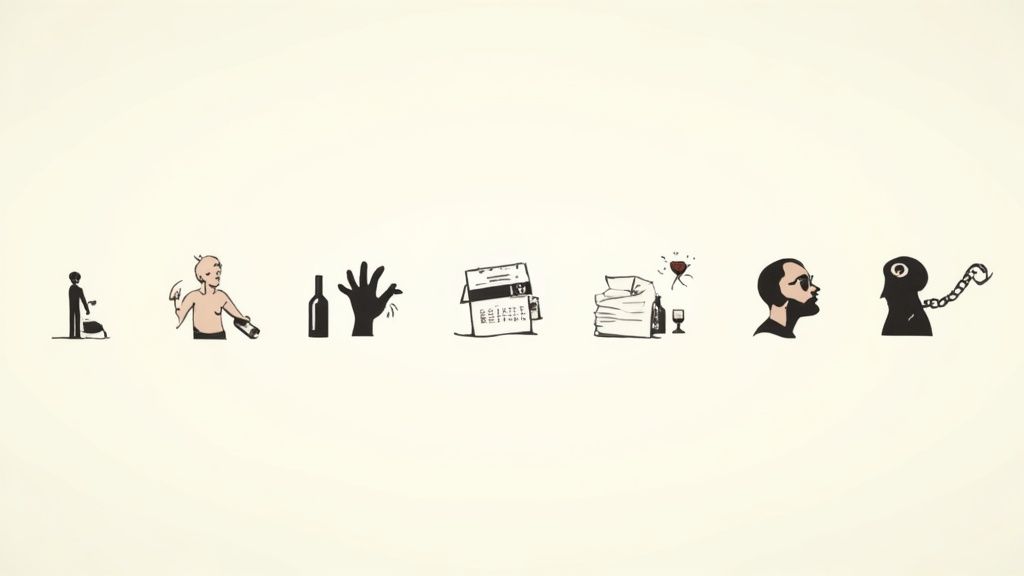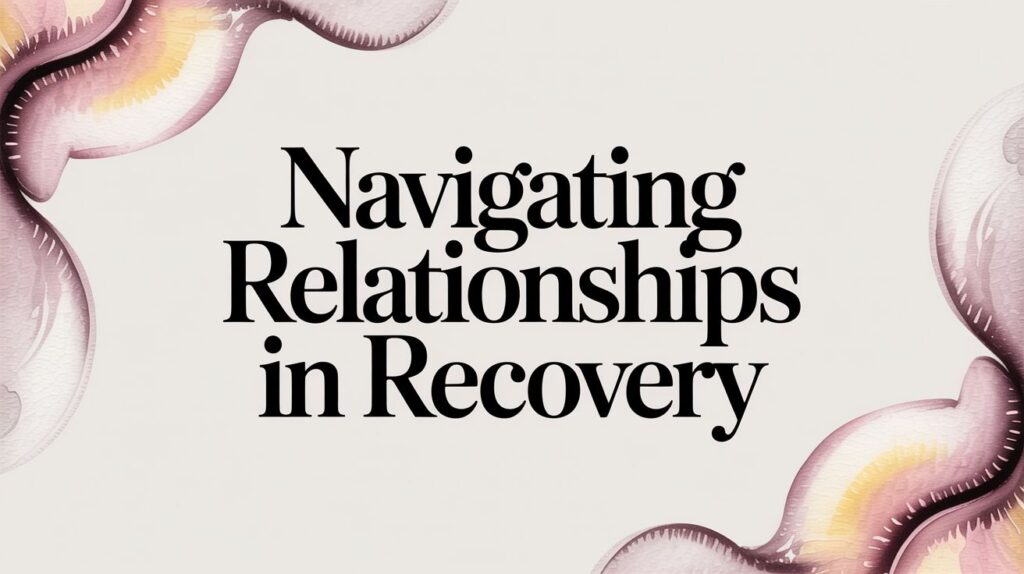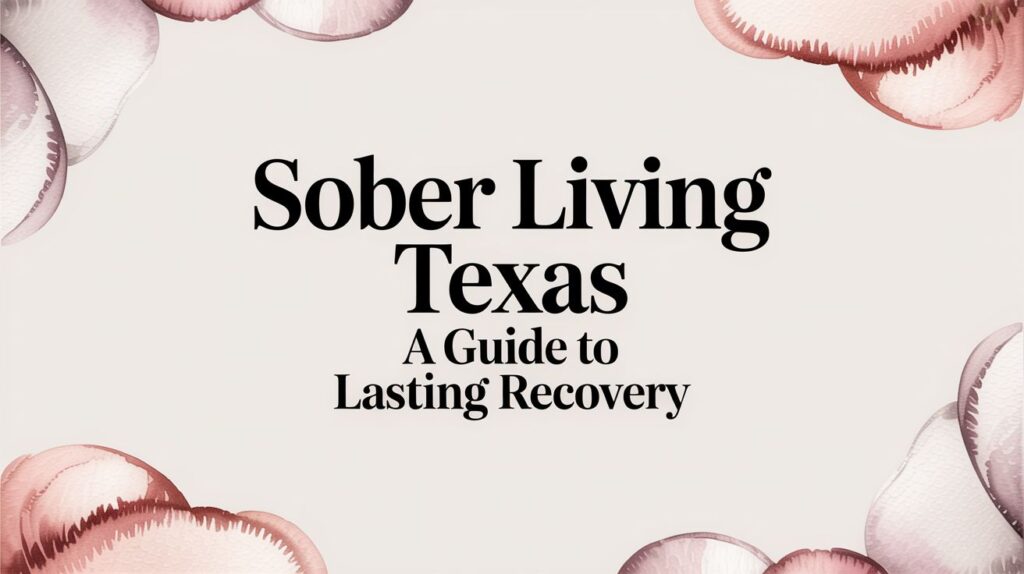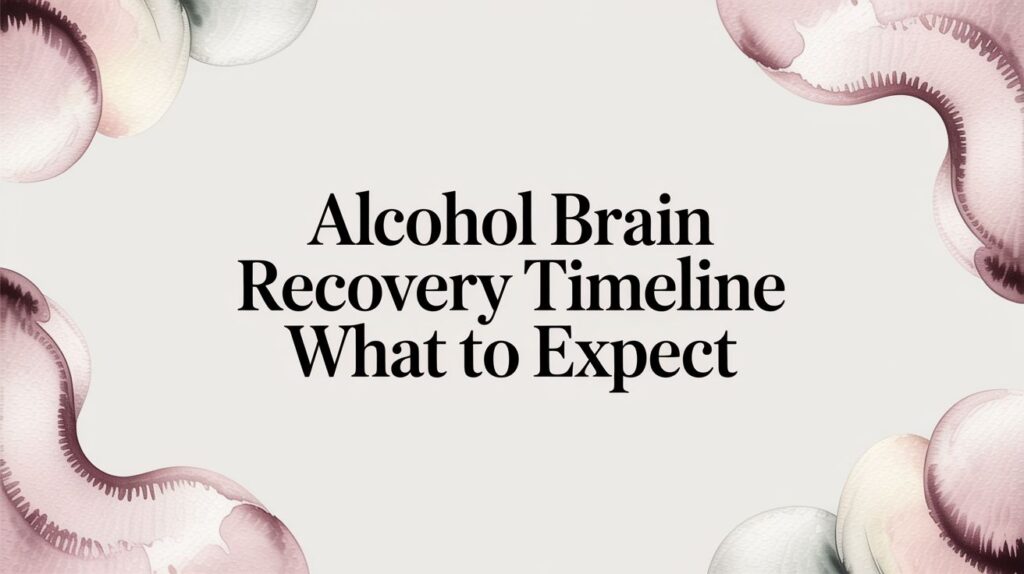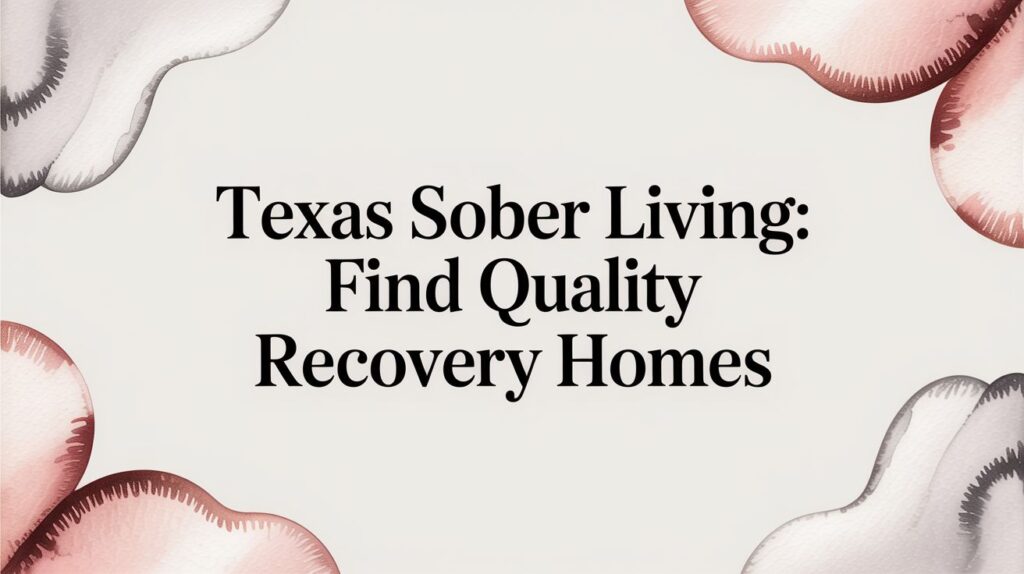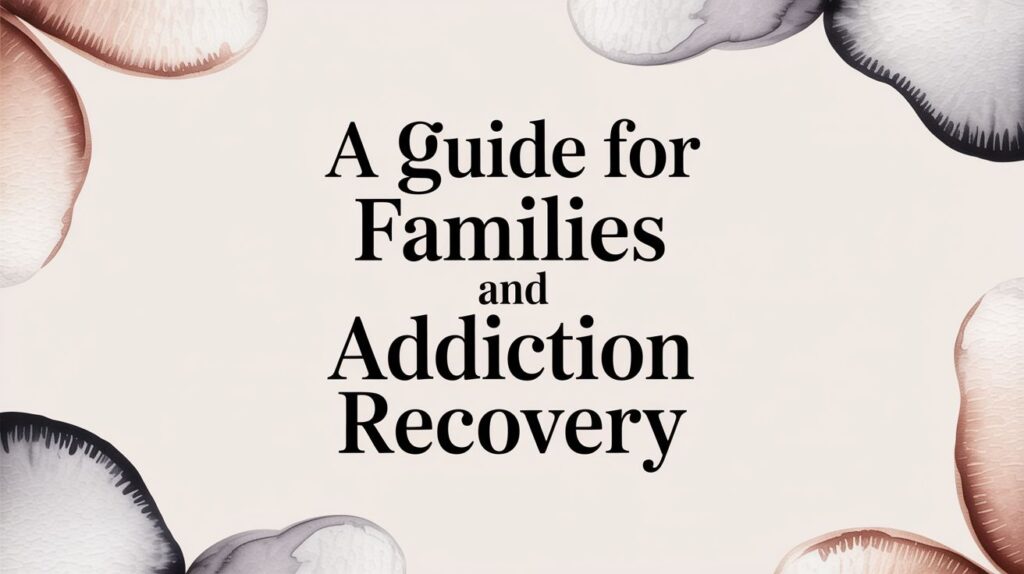A casual drink with friends, a glass of wine after a long day-for many, alcohol is a normal part of social life. But when does this common practice cross the line into something more serious? The transition from casual use to dependence is often gradual and deceptive, making it difficult to spot. Recognizing the early warning signs of alcohol addiction is a critical first step toward preventing long-term harm and seeking effective support. This guide breaks down the key indicators, offering clear examples and actionable insights to help you or a loved one identify problematic patterns.
To better grasp how alcohol can take hold, it can be helpful to consider the broader neurological underpinnings of compulsive behaviors and understanding the neurobiology of addiction. The process often begins subtly, with a slow escalation of consumption or a growing reliance on alcohol to cope with stress, eventually leading to more significant and disruptive behaviors.
Understanding these signs is not about judgment; it's about empowerment, providing the clarity needed to take control and begin a journey toward health and recovery. Below, we explore the specific behaviors and symptoms that signal it's time to pay closer attention to drinking habits and their impact on your life.
1. Tolerance and Escalating Consumption
One of the most significant and often overlooked warning signs of alcohol addiction is the development of tolerance. Tolerance occurs when your brain and body adapt to the regular presence of alcohol, requiring you to drink more to achieve the same effects you once felt with a smaller amount. This isn't just about "holding your liquor" well; it’s a physiological change that signals the beginning of physical dependence.
This escalating consumption is a direct response to your body’s adaptation. The initial feeling of relaxation or euphoria that came from one or two drinks now requires three, four, or even more. This gradual increase can be deceptive, making it seem like a natural progression rather than a critical signpost on the road to addiction.

What Escalating Consumption Looks Like
Recognizing tolerance requires an honest look at your drinking patterns over time. What was your baseline a year ago versus today?
- Social Drinking Changes: A person who used to feel tipsy after two beers at a social event now needs a six-pack to achieve the same feeling.
- Nightly Routines: Someone who previously enjoyed a single glass of wine to unwind might find themselves finishing an entire bottle, and eventually more, each night.
- Switching Beverages: You might find yourself switching from beer or wine to hard liquor like vodka or whiskey to get a faster, stronger effect.
This progression is a clear indicator that your body is working harder to process the alcohol, a hallmark of developing alcohol use disorder.
Actionable Steps to Assess Your Tolerance
If you suspect your tolerance is increasing, it's crucial to take objective steps to understand the reality of your consumption. Self-deception can easily mask the severity of the issue.
- Track Your Intake: Keep a detailed drinking diary for two weeks. Note the type, quantity, and time of each drink. This provides concrete data, removing guesswork.
- Seek Outside Perspective: Ask a trusted friend or family member if they have noticed a change in your drinking habits. An external viewpoint can offer clarity you may not have.
- Monitor Your Purchases: Review your bank or credit card statements. Are you spending significantly more on alcohol now than you were a few months ago? The numbers often tell a story we ignore.
2. Withdrawal Symptoms When Not Drinking
One of the most definitive warning signs of alcohol addiction is experiencing withdrawal symptoms when you stop or significantly reduce your drinking. Withdrawal occurs because your central nervous system has adapted to the constant presence of alcohol, which is a depressant. When the alcohol is removed, the brain rebounds into an overexcited state, causing a range of physical and psychological symptoms.
This is a critical sign of physical dependence, meaning your body now needs alcohol to function "normally." The symptoms can appear within hours of your last drink and vary in severity. They serve as a powerful, and often dangerous, signal that your body is struggling to rebalance itself without the substance it has come to rely on.
What Withdrawal Symptoms Look Like
Recognizing withdrawal involves paying attention to how your body and mind react when you don't drink. These symptoms are often the reason people continue drinking, just to avoid the discomfort.
- Mild Symptoms: A person may wake up with hand tremors (the "shakes"), anxiety, sweating, and a pounding headache that only a "hair of the dog" drink seems to fix.
- Moderate Symptoms: Someone trying to cut back might experience severe irritability, insomnia, nausea, and a persistent feeling of unease or dread.
- Severe Symptoms: In dangerous cases, individuals can suffer from hallucinations, high blood pressure, racing heart, fever, and seizures. This severe form, known as delirium tremens (DTs), is a medical emergency.
The need for a morning drink to "steady your nerves" is a classic example of using alcohol to self-medicate withdrawal, perpetuating the cycle of dependence.
Actionable Steps to Address Withdrawal
If you experience withdrawal symptoms, it is crucial to approach the situation with caution and prioritize safety. Attempting to quit "cold turkey" can be life-threatening if you have a significant physical dependence.
- Consult a Medical Professional: Before you stop drinking, speak with a doctor or an addiction specialist. They can assess your risk for severe withdrawal and recommend the safest course of action.
- Never Detox Alone: Severe alcohol withdrawal can escalate quickly. Ensure a trusted friend or family member is aware of your plans and can check on you or seek help if needed.
- Explore Medically Supervised Detox: The safest way to manage withdrawal is through a professional detoxification program where medical staff can monitor your vitals and provide medication to prevent severe complications.
- Address Co-occurring Issues: Withdrawal often magnifies underlying mental health conditions like anxiety or depression. Learn more about integrated treatment for dual diagnosis on alturarecovery.com to understand how these interconnected issues can be managed together for a more successful recovery.
3. Loss of Control Over Drinking Behavior
A defining characteristic of alcohol addiction is the loss of control over one's drinking behavior. This isn't about a single instance of overindulgence; it's a persistent pattern of being unable to manage when, where, and how much you drink. The intention to have just one or two drinks is consistently overridden by a compulsion to continue, a phenomenon often described as "one drink is too many, and a thousand are never enough." This inability to adhere to self-imposed limits is a critical warning sign that your relationship with alcohol has become unmanageable.
This loss of control is a core concept in addiction recovery, emphasized by organizations like Alcoholics Anonymous, which describes it as being "powerless over alcohol." It signals a shift from voluntary use to compulsive behavior, where the decision-making process is hijacked by the craving for alcohol, despite awareness of the negative outcomes.

What Loss of Control Looks Like
This warning sign manifests in broken promises to oneself and others. The struggle between the desire to control drinking and the inability to do so becomes a central conflict in daily life.
- Intention vs. Reality: You plan to have two beers with friends after work but end up staying until the bar closes, drinking far more than intended.
- Failed Moderation Attempts: You promise yourself or your family that you will only drink on weekends, but you consistently find reasons to drink on weeknights.
- Inappropriate Timing: Drinking occurs at risky or inappropriate times, such as before driving, during a work lunch break, or while responsible for children, despite knowing the potential consequences.
These scenarios highlight a fundamental disconnect between your intentions and your actions, a clear indicator that alcohol is exerting control over your choices.
Actionable Steps to Regain Control
If you recognize this pattern in your own life, taking deliberate steps is essential to assess the situation and begin to reclaim your autonomy.
- Set and Announce Limits: Before entering a situation with alcohol, set a specific, non-negotiable limit (e.g., "I will have one drink and leave by 9 PM"). Share this limit with a trusted friend who can help hold you accountable.
- Change Your Environment: Make alcohol less accessible. Avoid keeping it in your home and change your route to bypass liquor stores or bars that trigger cravings.
- Practice Saying 'No': In social settings, rehearse and practice politely but firmly declining additional drinks. This builds the mental muscle needed to stick to your decisions. If moderation repeatedly fails, this is a strong sign that complete abstinence may be the necessary path forward.
4. Neglecting Responsibilities and Relationships
A critical warning sign of alcohol addiction is when drinking begins to take precedence over essential life obligations and relationships. As alcohol use disorder progresses, the individual’s priorities shift, with obtaining and consuming alcohol becoming more important than their commitments to work, family, and personal well-being. This neglect often starts subtly but can escalate, causing significant damage to one's personal and professional life.
This shift happens because the brain’s reward system is rewired by addiction, making alcohol seem more crucial than activities and people that once brought joy and fulfillment. The compulsion to drink overrides rational decision-making, leading to a pattern of broken promises, missed deadlines, and strained connections. It's a clear sign that alcohol is no longer a part of life but has started to control it.
What Neglecting Responsibilities Looks Like
Recognizing this pattern involves observing a consistent failure to meet obligations where alcohol is either the direct or indirect cause. The excuses may vary, but the underlying reason is often the same.
- Professional Decline: A once-reliable employee frequently calls in sick, especially on Mondays, due to hangovers. They may miss important deadlines, show up late, or have a noticeable drop in performance.
- Family and Social Neglect: An individual consistently misses their children’s school plays or sports games. They might cancel plans with friends at the last minute to drink alone or prioritize going to a bar over a family dinner.
- Financial and Personal Care Issues: Bills go unpaid while a significant portion of income is spent on alcohol. Personal hygiene, home cleanliness, and other self-care routines may also deteriorate as drinking becomes the central focus.
Actionable Steps to Address This Behavior
If you or someone you know is neglecting responsibilities due to alcohol, taking proactive steps is vital to prevent further damage. Addressing the issue directly is more effective than ignoring it.
- Create Accountability: Set up a system with a trusted, non-judgmental friend or family member. Share your calendar of important events with them and ask them to check in, creating an external motivator to follow through.
- Establish Alcohol-Free Zones/Times: Designate specific times and situations where drinking is off-limits, such as the hours before a work meeting, during family events, or when handling financial tasks.
- Seek Professional Guidance: The strain on relationships, especially within a marriage, can be immense. Understanding how to navigate these challenges is crucial. Learning how to help an alcoholic husband or partner often requires professional support to rebuild trust and set healthy boundaries.
5. Drinking in Dangerous Situations
Another critical warning sign of alcohol addiction is when drinking starts to occur in situations where it poses a significant risk to personal safety or legal standing. This behavior shows that the compulsion to drink has begun to override natural self-preservation instincts and rational judgment. When the need for alcohol is prioritized over the safety of oneself and others, it is a clear indication that control is being lost.
This shift in risk assessment is a hallmark of substance use disorders. Activities that a person would never consider doing while sober, like driving or operating machinery, become acceptable after a few drinks. This disregard for consequences demonstrates how deeply alcohol has integrated into a person's life, moving from a recreational activity to a dangerous compulsion.
The following infographic highlights just how severe the consequences of drinking in dangerous situations can be, particularly regarding driving and workplace safety.

These statistics underscore a grim reality: the impaired judgment from alcohol contributes to a significant number of preventable deaths and injuries every single day.
What Drinking in Dangerous Situations Looks Like
This warning sign manifests when a person’s drinking directly creates a hazardous environment. It's not just about the amount consumed, but the context in which it happens.
- Driving Under the Influence: This is the most common example, from driving home after a night out to operating a vehicle after just one or two "quick drinks."
- Workplace Consumption: Having alcohol during a lunch break before returning to a job that requires focus or involves operating machinery.
- Childcare and Supervision: Drinking while responsible for the care and safety of children, where impaired reflexes and judgment could be catastrophic.
- Mixing with Medications: Consuming alcohol while taking prescription drugs that have explicit warnings against it, risking dangerous interactions.
Actionable Steps to Address Risky Behavior
If you recognize this pattern in yourself or a loved one, it's vital to create immediate safeguards to prevent a tragic outcome. This requires proactive planning and a firm commitment.
- Plan Your Transportation: Never leave the house without a clear, alcohol-free plan to get home. Arrange for a designated driver, save the numbers for taxi services, or have a rideshare app ready.
- Establish Zero-Tolerance Boundaries: Create firm rules for situations where drinking is non-negotiable, such as before driving, during work hours, or when caring for others.
- Consult Your Doctor or Pharmacist: Have an open conversation with a healthcare professional about how your medications interact with alcohol. Understand the specific risks involved.
- Recognize Impaired Judgment: Acknowledge that even one drink can affect your decision-making. The decision to not drink in a risky situation must be made before you take the first sip.
6. Persistent Cravings and Preoccupation
A powerful psychological component of alcohol addiction is the development of persistent cravings and a mental preoccupation with drinking. This goes far beyond simply wanting a drink; it involves intense, recurring thoughts and urges that can dominate your focus and disrupt daily life. These cravings are not a sign of weak willpower but a neurochemical response in the brain, which has begun to prioritize alcohol above other needs.
This mental fixation often manifests as a constant internal dialogue about alcohol. The mind becomes consumed with planning the next drink, ensuring there is always a sufficient supply, and structuring life around opportunities to consume it. This preoccupation is a critical warning sign that alcohol has shifted from a casual part of life to its central organizing principle.
What Preoccupation Looks Like
Recognizing this mental obsession requires paying attention to where your thoughts consistently drift. It’s a subtle but telling indicator of a deepening dependency.
- Clock-Watching: You find yourself frequently counting down the hours or minutes until you can have your first drink of the day, often feeling relief when that time arrives.
- Supply Anxiety: Experiencing significant anxiety or agitation when your alcohol supply is running low, and taking immediate steps to replenish it, regardless of the time or circumstances.
- Social Planning: Choosing social events, restaurants, or even vacation destinations based primarily on the availability and accessibility of alcohol. You might avoid activities where drinking isn't possible.
- Focus Impairment: Having trouble concentrating on work, conversations, or hobbies because your mind is preoccupied with thoughts of drinking.
This pattern demonstrates that alcohol has taken on an outsized importance in your mental and emotional landscape, a key feature of alcohol use disorder.
Actionable Steps to Manage Cravings
If you are struggling with a preoccupation with alcohol, there are proactive strategies to regain control. These techniques, central to many recovery programs like SMART Recovery, focus on managing urges rather than being controlled by them.
- Identify Your Triggers: Keep a log of when cravings occur. Note the time, your emotional state, and the environment. Recognizing patterns is the first step toward avoiding or managing these triggers.
- Practice Mindfulness: When a craving arises, instead of fighting it, try to observe it without judgment. Acknowledge the thought as a symptom of addiction that will pass. This technique, popularized by Dr. Jon Kabat-Zinn, can reduce its power.
- Develop Coping Strategies: Cravings are often linked to stress, boredom, or sadness. Building a toolkit of alternative coping skills for substance abuse is essential. This could include exercise, calling a friend, or engaging in a hobby to redirect your focus.
7. Social Isolation and Relationship Deterioration
A deeply concerning warning sign of alcohol addiction is the progressive withdrawal from social circles and the breakdown of important relationships. This isolation isn't a random occurrence; it's often a direct consequence of the addiction taking hold. As drinking becomes a central focus, it begins to push everything and everyone else to the periphery, creating a self-perpetuating cycle of loneliness and increased substance use.
This withdrawal can be driven by shame over drinking habits, a preference for drinking alone without judgment, or escalating conflicts with loved ones who express concern. The individual may start choosing alcohol over social events, family gatherings, and friendships, fundamentally altering their social landscape and severing vital connections.
What Social Isolation Looks Like
The erosion of relationships is often gradual, making it hard to spot at first. It manifests as a pattern of prioritizing drinking over connection.
- Avoiding Social Events: Someone might consistently decline invitations to family dinners, parties, or gatherings with friends, especially if alcohol won't be the main focus. They may offer vague excuses or simply stop responding.
- Choosing Solitude: An individual may prefer drinking at home alone rather than going out with friends, finding it easier to hide the extent of their consumption.
- Pushing People Away: Friendships often end when friends or family members voice their concerns about the person's drinking. The individual may become defensive, leading to arguments and eventual distance.
- Abandoning Hobbies: Previously enjoyed group activities like team sports, book clubs, or community volunteering are abandoned because they interfere with drinking time or don't involve alcohol.
This retreat from a support system is a significant red flag, as it removes the very connections that are crucial for emotional well-being and recovery.
Actionable Steps to Assess Your Relationships
If you fear alcohol is damaging your social life, it's vital to take an honest inventory of your connections. Denial can easily obscure the impact your drinking has on others.
- List Your Connections: Write down the names of your closest friends and family members. When was the last time you had a meaningful, sober interaction with each of them?
- Initiate a Conversation: Reach out to a trusted loved one you feel has grown distant. Ask them, "I feel like we haven't connected in a while, is everything okay between us?" Their response may provide valuable insight.
- Review Your Calendar: Look back at the past few months. How many social invitations have you declined? How many times did you choose to drink alone instead of being with others?
Recognizing the damage is the first step toward mending these essential bonds. Rebuilding trust and connection is a core component of recovery. Learn more about navigating recovery and relationships.
Comparison of 7 Key Alcohol Addiction Warning Signs
| Sign/Behavior | Implementation Complexity 🔄 | Resource Requirements ⚡ | Expected Outcomes 📊 | Ideal Use Cases 💡 | Key Advantages ⭐ |
|---|---|---|---|---|---|
| Tolerance and Escalating Consumption | Moderate – tracking consumption over time | Low – self-monitoring tools like diaries | Early detection of increasing alcohol use; objective measure | Early intervention; self or family observation | Easy to measure; noticed by others; helps prompt early action |
| Withdrawal Symptoms When Not Drinking | High – requires medical knowledge and supervision | High – medical support needed | Clear sign of physical dependence; risk of severe symptoms | Detox periods; clinical intervention | Medically recognized; motivates treatment; unmistakable sign |
| Loss of Control Over Drinking Behavior | Moderate – behavioral assessment needed | Moderate – monitoring and support systems | Identification of addiction stage; highlights need for help | Clinical and social settings; behavioral therapies | Observable behavior; strong indicator for treatment need |
| Neglecting Responsibilities and Relationships | Moderate – requires observation over time | Low to moderate – social/family input | Decline in life functioning and relationships | Family interventions; social support | Observable consequences; motivates change via social accountability |
| Drinking in Dangerous Situations | Low to moderate – clear objective criteria | Low – awareness and monitoring | High risk of legal/safety consequences | Legal/occupational settings; safety assessments | Clear-cut legal and safety flags; potential for immediate intervention |
| Persistent Cravings and Preoccupation | High – psychological and behavioral complexity | Moderate – therapy and possible medication | Long-term relapse risk; psychological challenge | Psychological treatment; relapse prevention | Well-researched; treatable through therapy and meds; motivates recovery |
| Social Isolation and Relationship Deterioration | Moderate – requires social and psychological analysis | Moderate – support groups, therapy | Deterioration of social supports; increased relapse risk | Family/social therapy; recovery planning | Early social warning; enhances recovery through relationship rebuilding |
From Recognition to Action: Your Path to Recovery
Acknowledging the patterns discussed in this article, from escalating tolerance to neglecting responsibilities, is the single most important step toward healing. Recognizing these warning signs of alcohol addiction in yourself or someone you care about moves the issue from the shadows into the light. It’s a moment of profound courage where denial recedes and the possibility for a healthier future begins to take shape.
This recognition is not an admission of failure; it is an act of self-preservation and strength. Alcohol use disorder is a recognized medical condition, driven by complex neurological, genetic, and environmental factors. It is not a reflection of your character or willpower. Just as you would seek professional help for diabetes or heart disease, addressing alcohol addiction requires specialized, compassionate, and evidence-based care.
Key Takeaways: From Signs to Solutions
The journey from acknowledgment to action involves understanding that these signs are not isolated incidents but interconnected symptoms of an underlying condition.
- Behavioral Signs: Loss of control, drinking in dangerous situations, and neglecting work or family are clear indicators that alcohol has taken a disruptive role in your life.
- Physical Signs: Increasing tolerance, experiencing withdrawal symptoms like tremors or anxiety, and persistent cravings are physiological signals that your body has become dependent on alcohol.
- Social Signs: Withdrawing from hobbies, isolating from loved ones, and relationship deterioration highlight the profound impact addiction has on your connection to others and to yourself.
The cumulative effect of these signs can severely impact mental health, leading to feelings of hopelessness, depression, and anxiety. It is crucial to be aware that alcohol addiction can sadly lead to severe mental health challenges. For those struggling with the most difficult of these feelings, it's vital to seek immediate help and find resources dedicated to understanding suicidal thoughts and navigating them safely.
Your Next Steps Toward Healing
If you see these warning signs, the most powerful next step is to start a conversation. You don't have to have all the answers or a perfect plan. Reaching out to a trusted friend, family member, or a qualified professional can break the cycle of isolation that addiction thrives on.
Professional guidance is essential in creating a structured, safe, and effective path forward. Therapies such as Cognitive Behavioral Therapy (CBT), Dialectical Behavior Therapy (DBT), and Eye Movement Desensitization and Reprocessing (EMDR) are proven to help individuals uncover the root causes of their addiction, develop healthy coping mechanisms, and build a resilient foundation for long-term sobriety. Don't wait for the consequences to worsen. The path to recovery is available, and it begins with your decision to seek support today.
At Altura Recovery, we specialize in guiding individuals through this transformative journey with flexible and comprehensive outpatient programs. If you recognize these warning signs and are ready to take control of your life, contact our compassionate team to learn how our personalized treatment plans can help you heal. Explore your options and start your recovery by visiting Altura Recovery.

